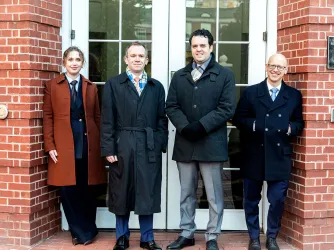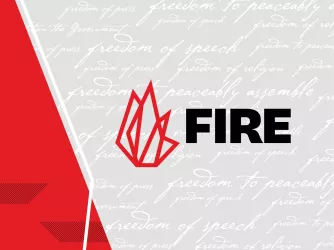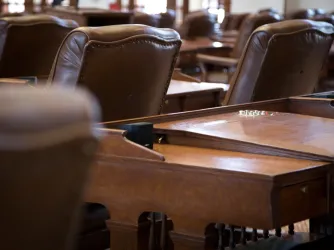Table of Contents
Free Speech on Campus: Just For a 'Select Few'?
On October 25, The New York Times published an op-ed by my colleague Greg Lukianoff detailing concerns about threats to student and faculty free speech rights on our nation's college campuses. Most of the responses to Greg's argument published by the Times were positive, but one letter featured in the paper's pages was critical. The letter's authors—Emily May, executive director and cofounder of Hollaback, an anti-street-harassment organization, and Selena Shen, chairwoman of Students Active for Ending Rape (SAFER)—wrote:
Students at college campuses across the country are routinely subjected to sexual harassment and racist and homophobic bullying, often under the guise of "humor" and free speech. On American college campuses, 51 percent of men openly admit to sexually harassing their classmates. While the behavior ranges from careless to cruel, harassment effectively robs students of their right to a safe learning environment.
All students should be entitled to an education without intimidation and bullying. Free speech is a valued right, and we're working together to create safe learning environments for everyone — not just the select few.
May and Shen's response raises important points, and I'm happy to reply. Given the admirable aims of both Hollaback and SAFER, it's useful to clarify exactly where FIRE agrees and disagrees with their letter.
First, our common ground, which is significant. FIRE strongly believes that colleges have both a legal and moral responsibility to address and end conduct that prevents any student from obtaining an education. Students must be able to learn in an environment free from harassment. Any college that turns a blind eye to serious harassment may be properly held liable under federal anti-discrimination laws like Title IX.
Now our points of disagreement—and these are significant, too.
One central disagreement is definitional. Given the limited space afforded by a letter to the editor, May and Shen understandably don't provide readers their definition of harassment. But they cite a statistic from a 2006 American Association of University Women report that relied on a far broader, vaguer definition of sexual harassment than the precise one fashioned by Justice Sandra Day O'Connor and the Supreme Court of the United States in the landmark 1999 case of Davis v. Monroe County Board of Education. The definition used in the AAUW report was "intentionally broad"; the authors acknowledged that it would include protected speech and other conduct, regardless of "whether or not the behavior is, or even should be, illegal." So while the report's definition may have been useful for its authors' purposes, a public college that maintained a similarly broad, vague definition would violate its students' First Amendment rights. Federal courts have consistently struck down broad or vague harassment policies in decisions dating back more than 20 years.
It's worth taking a closer look at the Davis definition, given that it remains the Supreme Court's only guidance on student harassment and is thus controlling precedent for public universities. In ruling that schools could be found liable for damages under Title IX for ignoring sexual harassment, the Davis Court defined student-on-student sexual harassment as conduct "so severe, pervasive, and objectively offensive" that the targeted student cannot take advantage of a school's resources and opportunities. This definition strikes a careful, necessary balance between a school's twin obligations to prohibit harassment and protect free speech. Under the Davis standard, all students are protected from harassment and bullying and guaranteed safe, secure access to educational benefits—and every student's First Amendment rights are protected, too.
The Davis standard's value lies in its objectivity. Under a subjective definition of harassment, students and faculty may be punished for protected speech depending on the particular sensibilities of a given student or administrator, allowing for the censorship of art, poetry, satire, debate, dissent, scholarship, and much more. In contrast, Davis' "reasonable person" standard gives the First Amendment requisite breathing room, prohibiting harassment while ensuring that students and faculty won't be punished for reading a book with the "wrong" cover, teaching a class on the "wrong" subject, writing articles expressing the "wrong" viewpoint, or criticizing an administrator using the "wrong" words.
Disappointingly, May and Shen suggest that while "[f]ree speech is a valued right," FIRE's work in defense of the First Amendment serves to benefit "just the select few." This is frustrating for several reasons. First, FIRE is proudly nonpartisan. We stand ready to defend free expression from across the ideological spectrum. For example, in just the past few months, we have defended the rights of the Feminist Alliance and the Gay-Straight Student Union to protest Representative Paul Ryan at Christopher Newport University in Virginia; the right of a libertarian student to criticize both President Barack Obama and Governor Mitt Romney via a dorm room poster; the right of students at North Carolina State University to engage in "uncivil" speech"; and the right of students and faculty in the University of California system to criticize either side of the Israeli-Palestinian conflict. FIRE's consistent and principled defense of freedom of expression on campus protects all students, not "just the select few."
But perhaps more disappointing is May and Shen's implicit argument that defending the First Amendment and freedom of expression serves to benefit "just the select few," rather than every student and every American. This suggestion betrays a sadly meager conception of the essentiality of free speech for advancing the civil rights of all Americans, both historically and moving forward as a nation. The civil rights advances that have driven the country towards the more perfect union our Constitution anticipates have all relied on the First Amendment's protections for their progress. As the Reverend Dr. Martin Luther King, Jr. memorably said, "the greatness of America is the right to protest for rights." It is precisely this First Amendment protection for "the peaceful expression of unpopular views" that the Supreme Court cited in 1963 when deciding Edwards v. South Carolina, protecting the right of African-American high school and college students to carry signs reading "Down with segregation."
Edwards may seem a far cry from the college campus, but it isn't; the underlying principle is one and the same. In fact, the Supreme Court has repeatedly emphasized the dynamic link between free speech on campus and the health of our modern liberal democracy. In defending the First Amendment right of Marxist professor Paul Sweezy in 1957's Sweezy v. New Hampshire, the Court wrote:
The essentiality of freedom in the community of American universities is almost self-evident. No one should underestimate the vital role in a democracy that is played by those who guide and train our youth. To impose any strait jacket upon the intellectual leaders in our colleges and universities would imperil the future of our Nation... Teachers and students must always remain free to inquire, to study and to evaluate, to gain new maturity and understanding; otherwise our civilization will stagnate and die.
Illiberal speech codes—like free speech zones, civility oaths, and broad, vague harassment policies—threaten our democracy by miseducating today's students about the importance of free speech, even for those ideas and speakers that offend us. Properly defined, harassment is not protected by the First Amendment. But in our pluralistic, diverse democracy, we must all remember that there is no "right not to be offended" under the First Amendment. Instead of censorship, the answer to offensive speech must always be more speech—to holler back.
Recent Articles
Get the latest free speech news and analysis from FIRE.

VICTORY: Jury finds Tennessee high school student’s suspension for sharing memes violated the First Amendment

DOJ must not investigate elected officials for criticizing immigration enforcement

FIRE statement on calls to ban X in EU, UK
